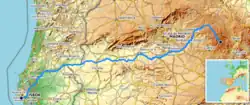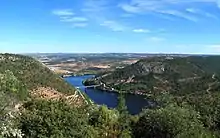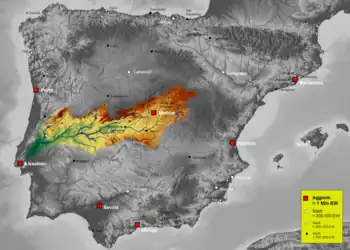Tagus
The Tagus (/ˈteɪɡəs/ TAY-gəs; Spanish: Tajo [ˈtaxo]; Portuguese: Tejo [ˈtɛʒu]; see below) is the longest river in the Iberian Peninsula. The river rises in the Montes Universales near Teruel, in mid-eastern Spain, flows 1,007 km (626 mi), generally westward with two main south-west sections, and empties into the Atlantic Ocean in Lisbon. Its drainage basin covers 80,100 km2 (30,927 sq mi) – exceeded in the peninsula only by the Douro. Several dams and diversions supply drinking water to population centers of central Spain and Portugal, and dozens of hydroelectric stations produce power. Between dams it follows a very constricted course, but after Almourol, Portugal, it expands into a wide alluvial valley, with a floodplain. It culminates in a large estuary at the Port of Lisbon in the capital city of Portugal.
| Tagus | |
|---|---|
 View of Tagus River in Toledo, Spain | |
 Path of the Tagus through the Iberian Peninsula | |
| Etymology | Vulgar Latin taliāre, "to cut through" |
| Location | |
| Country | Spain, Portugal |
| Physical characteristics | |
| Source | Fuente de García, Montes Universales |
| • location | Frías de Albarracín, Spain |
| • coordinates | 40°19′16″N 1°41′49″W |
| • elevation | 1,593 m (5,226 ft) |
| Mouth | Estuary of the Tagus, Atlantic Ocean |
• location | Lisbon, Portugal |
• coordinates | 38°41′28″N 9°10′16″W |
• elevation | 0 m (0 ft) |
| Length | 1,007 km (626 mi) |
| Basin size | 80,100 km2 (30,900 sq mi) |
| Discharge | |
| • average | 500 m3/s (18,000 cu ft/s) |
| Basin features | |
| Tributaries | |
| • left | Guadiela, Algodor, Gévalo, Ibor, Almonte, Salor, Sever |
| • right | Gallo, Jarama, Guadarrama, Alberche, Tiétar, Alagón, Zêzere |
.jpg.webp)

The source is specifically, in political geography, at the Fuente de García in the Frías de Albarracín municipality; in physical geography, in the Sistema Ibérico (Iberian System), covering the notably high mountains of the Sierra de Albarracín Comarca. The most plentiful tributaries (originating in the Central System mountain range) are on right bank, to the north. The river flows 716 km (445 mi) in Spain, 47 km (29 mi) along the two countries' borders and 275 km (171 mi) in Portugal.
The river flows through many cities, including Aranjuez, Toledo and Talavera de la Reina in Spain, and Abrantes, Santarém, Almada and Lisbon in Portugal. The Spanish capital, Madrid, lies on the right-bank side of the Tagus basin.
Course

In Spain

The first notable city on the Tagus is Sacedón. Below Aranjuez it receives the combined flow of the Jarama, Henares, Algodor and Tajuña. Below Toledo it receives the Guadarrama River. Above Talavera de la Reina it receives the Alberche. At Valdeverdeja is the upper end of the long upper reservoir, the Embalse de Valdecañas, beyond which are the Embalse de Torrejon, into which flows the Tiétar, and the lower reservoir, formed by the Alcántara Dam, into which flows the Alagón at the lower end.
A canal and aqueduct are between the Tagus and the Segura for the Tagus-Segura Water Transfer.

In Portugal
After forming the border it enters Portugal, passing Vila Velha de Ródão, Abrantes, Constância, Entroncamento, Santarém and Vila Franca de Xira at the head of the long narrow estuary, which has Lisbon at its mouth. The estuary is protected by the Tagus Estuary Natural Reserve. Two bridges span the river at Lisbon: the Vasco da Gama Bridge – the second longest bridge in Europe, with a total length of 17.2 km (10.7 mi) – and the 25 de Abril Bridge. The Port of Lisbon, straddling its mouth, is one of Europe's busiest.
The Portuguese Alentejo region and the former Ribatejo Province take their names from the river: Alentejo, from além Tejo ("beyond the Tejo") and Ribatejo probably from arriba Tejo (an archaic phrase for "upper Tejo"). However, the Spanish word riba means "riverside", or "riviera", implying that Ribatejo can also mean very generically "the side of Tejo". Many instances of towns in Spain have this prefix.
Name
The river's Latin name is Tagus. While the etymology is unclear, the most probable etymological origin for the hydronym Tagus is Indo-European *(s)tag- ('to drip').[1] It is known under different names in the languages of Iberia: Basque: Tajo, Catalan: Tajo, Galician: Río Texo, Mirandese: Riu Teijo, Portuguese: Tejo, Spanish: Tajo. It is known in Italian as Tago and Greek as Τάγος (Tágos).
Geology
The lower Tagus region in Portugal is a seismically active area. Major earthquakes in the Lower Tagus include those of 1309, 1531, and 1909.[2][3]
History

The Pepper Wreck, properly the wreck of the Nossa Senhora dos Mártires, is a shipwreck located and excavated at the mouth of the Tagus between 1996 and 2001.
The river had strategic value to the Spanish and Portuguese empires, as it guarded the approach to Lisbon.
In popular culture
A major river, the Tagus is brought to mind in the songs and stories of the Portuguese. A popular fado song in Lisbon notes that, while people get older, the Tagus remains young ("My hair getting white, the Tagus is always young"). The author, Fernando Pessoa, wrote a poem[4] that begins:
The Tagus is more beautiful than the river that flows through my village.
But the Tagus is not more beautiful than the river that flows through my village...
Richard Crashaw (died 1649) wrote a poem "Saint Mary Magdalene, or the Weeper". This refers to the "Golden" Tagus as wanting Mary Magdalene's silver tears. In classical poetry, the Tagus was famous for its gold-bearing sands (the catalogued works of: Catullus 29.19; Ovid's Amores 1.15.34; Juvenal's Satires 3.55; and others).
See also
References
- Curchin, Leonard A. (2007). "Toponyms of Lusitania: a re-assessment of their origins" (PDF). Conímbriga. XLVI: 151. doi:10.14195/1647-8657_46_7.
- Hobbs, William Herbert (1907). Earthquakes: An Introduction to Seismic Geology. New York: D. Appleton and Company. pp. 142–144. Downloadable Internet Archive
- "Sismo sentido em Lisboa na mesma zona dos grandes abalos de 1531 e 1909" [Earthquake felt in Lisbon in the same area as the great earthquakes of 1531 and 1909] (in Portuguese). Diário de Notícias. 18 March 2021. Retrieved 29 October 2021.
- Pessoa, Fernando (1999). Fernando Pessoa and Co.: Selected Poems. Translated by Zenith, Richard. Grove Press. p. 55. ISBN 9780802136275.